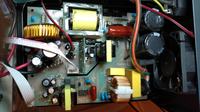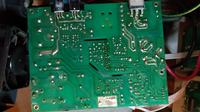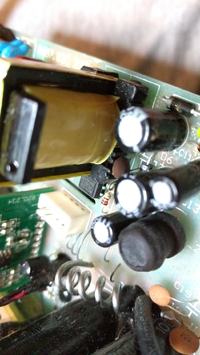ro0ter
Junior Member level 3
- Joined
- Jan 14, 2012
- Messages
- 26
- Helped
- 0
- Reputation
- 0
- Reaction score
- 0
- Trophy points
- 1,281
- Location
- Cluj, Romania
- Activity points
- 1,656
Hello everyone,
It's been a while since I visited this forum, yet my bench PSU is now toasted but I do not know for what reason (last time it worked like a charm, but baby came and I did not turned it on at all in the past 6m).
It is a switching bench power supply able to provide 30v and 10a (never went above 5~6a). Indeed, it is a cheap PSU, but I'd rather repair it than replace it.
The PSU won't even start normally, its LCD backlight and digits are dimply flickering and a light click can be heard (although there are no relays inside). After I turn it off, the flickering is more rapid until it dies. The power on switch breaks both live and null.
I inspected thoroughly the PCB and found no swollen caps and no visible damage, but only a resistor which seemed very heated (couldn't distinguish the colors) but after desiring and measuring it I could tell it's 226k +/-1%, and the "browned" colors could be red-red-blue-orange-brown, indeed. This resistor sits next to the TNY277PN ic, at the enable / under voltage pin (will try to draw a schematic and upload it later on).
However, since the resistor seems functional, I'm not sure if I am wrong or not by suspecting it. It has a voltage drop off 265v while the device is on. I have not measured the 5v rail, but I suppose this is the problem; I would say the TNY277PN and the small-to-medium inductor next to it (plus passives, optocouplers) are producing the 5v required by the control circuitry. Will measure it later on today if the little one allows me .
.
If anyone had any advice or different assumption, I am open to follow it.
Thank you all!
It's been a while since I visited this forum, yet my bench PSU is now toasted but I do not know for what reason (last time it worked like a charm, but baby came and I did not turned it on at all in the past 6m).
It is a switching bench power supply able to provide 30v and 10a (never went above 5~6a). Indeed, it is a cheap PSU, but I'd rather repair it than replace it.
The PSU won't even start normally, its LCD backlight and digits are dimply flickering and a light click can be heard (although there are no relays inside). After I turn it off, the flickering is more rapid until it dies. The power on switch breaks both live and null.
I inspected thoroughly the PCB and found no swollen caps and no visible damage, but only a resistor which seemed very heated (couldn't distinguish the colors) but after desiring and measuring it I could tell it's 226k +/-1%, and the "browned" colors could be red-red-blue-orange-brown, indeed. This resistor sits next to the TNY277PN ic, at the enable / under voltage pin (will try to draw a schematic and upload it later on).
However, since the resistor seems functional, I'm not sure if I am wrong or not by suspecting it. It has a voltage drop off 265v while the device is on. I have not measured the 5v rail, but I suppose this is the problem; I would say the TNY277PN and the small-to-medium inductor next to it (plus passives, optocouplers) are producing the 5v required by the control circuitry. Will measure it later on today if the little one allows me
If anyone had any advice or different assumption, I am open to follow it.
Thank you all!


